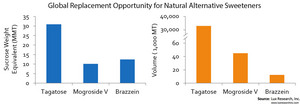BOSTON, MA--(Marketwired - Jan 26, 2016) - Global consumption of sweeteners -- sucrose and sugar alternatives -- will rise by 30% to 292 million metric tons (MMT) in 2024. Along with trends toward natural and healthy ingredients, this growth will create big opportunities for each of several emerging alternative natural sweeteners, according to Lux Research.
Today, alternative sweeteners account for 22% of the total sweetener market, but natural sweetener alternatives represent only 1% of the sweetener market. Recent attention has focused on three nascent natural alternative sweeteners -- tagatose, derived from dairy; mogroside V, extracted from monk fruit; and brazzein, a sweet protein which comes from the oubli plant. Alternatives like these have the potential to replace between 2% and 25% of total sucrose across product categories like bakery and cereal, beverage, and confection.
"Sucrose remains nearly impossible to fully mimic, and no one alternative sweetener provides a magic bullet. Consequently, a good strategy for developers is to combine several and derive a higher percentage of functionalities," said Camilla Stice, Lux Research Analyst and lead author of the report titled, "Natural Alternative Sweeteners: Assessing the True Addressable Market."
"Developers must also recognize several additives needed for reformulation and consider the additive costs, rather than focus on the sole cost of the replacement sweetener," she added.
Lux Research analysts studied the market opportunity for three natural alternative sweeteners. Among their findings:
- Each sweetener functionally capable of replacing over 10 MMT sugar globally. Tagatose has the potential to replace 31 MMT of sugar used worldwide while mogroside V and brazzein could replace 10 MMT and 13 MMT, respectively. To reach these levels of replacement, developers must successfully produce 34 MMT tagatose while much less of mogroside V (45,000 MT) and brazzein (12,500 MT) is required due to the compounds' high sweetness intensity.
- Current production falls short. Production volumes of nascent natural alternative sweeteners are low or virtually non-existent on account of high-priced feedstock, low yields, scarce growth, and costly extraction processes. To reach full potential, developers must increase production of mogroside V by 200-fold and successfully scale production of tagatose and brazzein for market entry.
- New production technologies hold promise yet development hurdles pose challenges. The lure of capitalizing on sucrose's bad name brings several production technologies to bat, including synthetic biology, enzymatic transformation, and biopharming techniques. However, no current solution successfully delivers adequate sweetener volumes. Developers must address massive scale up challenges before these alternative sweeteners become a mass-market reality.
The report, titled "Natural Alternative Sweeteners: Assessing the True Addressable Market," is part of the Lux Research Food and Nutrition Intelligence service.
About Lux Research
Lux Research provides strategic advice and ongoing intelligence for emerging technologies. Leaders in business, finance and government rely on us to help them make informed strategic decisions. Through our unique research approach focused on primary research and our extensive global network, we deliver insight, connections and competitive advantage to our clients. Visit www.luxresearchinc.com for more information.
Contact Information:
Contact:
Carole Jacques
Lux Research, Inc.
617-502-5314
carole.jacques@luxresearchinc.com
